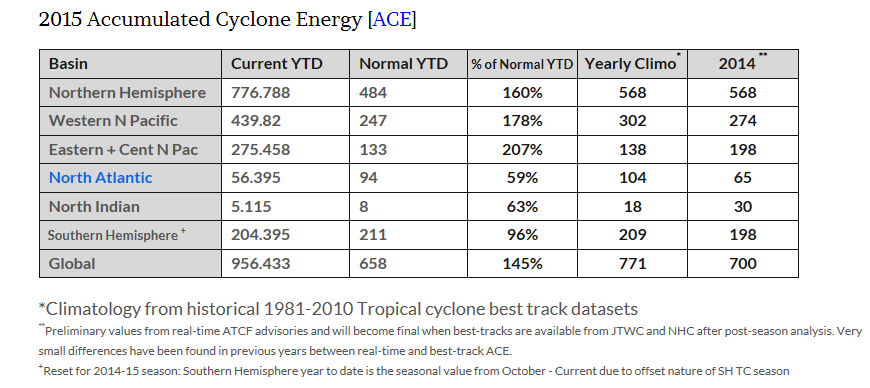12:45 PM | Study shows hurricanes in global downward trend during last 25 years
Paul Dorian
Overview
Whether these findings are part of normal "year-to-year" variability or indeed part of a long-term trend, the results of a new study are quite interesting. Philip Klotzbach (Department of Atmospheric Science, Colorado State University) and Christopher Landsea (NOAA/NWS/National Hurricane Center) have just published the results of a study in which they conclude shows “large, significant downward trends” in Accumulated Cyclone Energy in the Northern Hemisphere, the Southern Hemisphere and globally during the 25-year period of 1990-2014. In addition, the study has found “small, insignificant” trends in intense (category 4-5) hurricane frequency and percentage in the same 25-year period on a global basis. The results of this study have been published in the October edition of the Journal of Climate: http://journals.ametsoc.org/doi/abs/10.1175/JCLI-D-15-0188.1).
Accumulated Cyclone Energy (ACE)
Accumulated Cyclone Energy (ACE) is a commonly-used metric for tropical activity because it is not dependent on exact numbers of named storms or hurricanes, but rather is based on both the intensity and longevity of all tropical storms and hurricanes (so a long-lived tropical storm could contribute as much ACE as a short-lived storm that reached hurricane intensity). The figure below from the Klotzbach and Landsea journal article displays the ACE levels for the 45-year period from 1970 through 2014. The top half of the figure displays ACE by year for each of the six global tropical cyclone basins since 1970. These values are combined into hemispheric and global sums in the bottom half of the figure. There has generally been a decreasing trend in ACE since the early 1990s when a prolonged El Nino event enhanced activity in the North Pacific.
[Accumulated Cyclone Energy (ACE) 1970-2014; courtesy Klotzbach and Landsea (1 October 2015, Journal of Climate)]
This year’s tropical activity
In terms of ACE for 2015, it has been very active in the Pacific Ocean aided in large part by a strong El Nino event (warmer-than-normal water) in the tropics. Indeed, the ACE values are well above normal in both the western North Pacific and the eastern/central North Pacific (table below; data courtesy Ryan Maue of Weather Bell Analytics; http://models.weatherbell.com/tropical.php). On the other hand, the Atlantic Ocean has actually been below normal with respect to ACE and that is partly due to the same El Nino event that has helped to fuel Pacific Ocean tropical storms. Evidence shows that in El Nino years, there is an added level of wind shear in the tropical Atlantic Ocean which tends to inhibit tropical storm formation. The downturn in Atlantic Basin tropical activity during 2015 has helped keep alive a 10-year drought in the US with respect to major hurricane (categories 3, 4 and 5) strikes. In fact, we have just passed the 10-year anniversary for the last major hurricane landfall in the US (Wilma in Florida, October 2005) which is the longest drought ever logged in the record-keeping era.
[2015 Accumulated Cyclone Energy (ACE) on a global basis; data courtesy Ryan Maue, Weather Bell Analytics]
Looking ahead to the tropics
There is a word of caution for the US, however, as this year’s strong El Nino event in the tropical Pacific Ocean is quite likely to weaken during 2016 and the “beneficial” effect of higher-than-normal wind shear in the Atlantic Basin is likely to diminish by next summer potentially leading to an uptick in activity. In fact, this potential increase in Atlantic tropical activity next year could even extend into 2017 as La Nina conditions (colder-than-normal waters) are quite possible by that time in the tropical Pacific Ocean. Meanwhile, it is entirely possible that at the same time the Atlantic Ocean tropical activity potentially increases during the next couple of years, the Pacific Ocean could experience somewhat quieter conditions compared to today as sea surface temperatures drop relative-to-normal with the gradual demise of El Nino.


